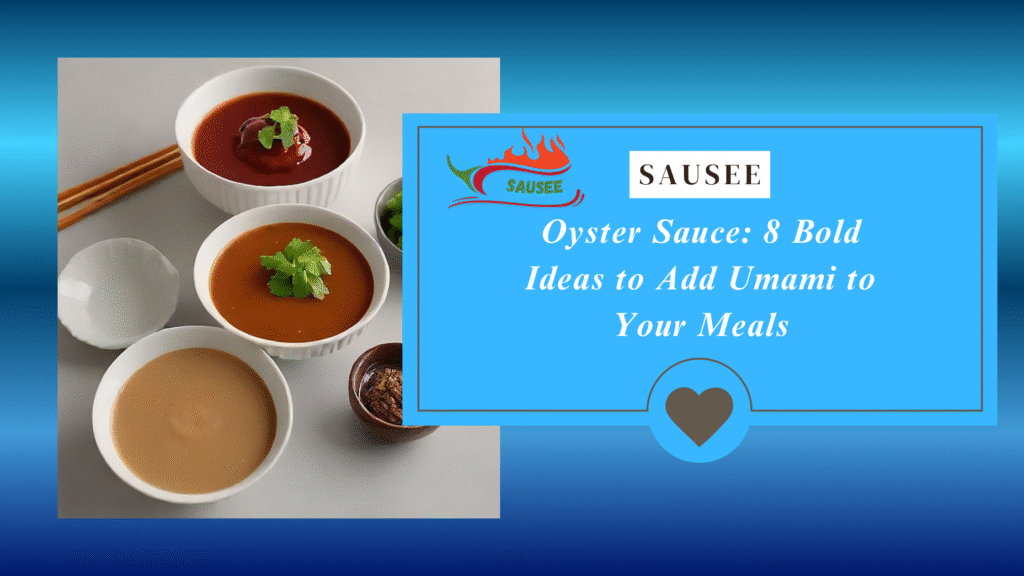Table of Contents
Introduction
Oyster sauce is what provokes the feeling of a rich, savory, deeply satisfying stir-fry, that you can never quite place why you feel that way, in case you have ever tasted this kind of stir-fry before.
Oyster sauce was a creation of the Cantonese cuisine, developed in the 1800s when a cook spilled an oyster broth and inadvertently allowed it to be overcooked to a dark, thick glaze. The result? A naturally sweet, salty, and savory sauce that has turned out to be a staple in kitchens throughout Asia, and now the world.
The important thing about the Oyster sauce is that it possesses a strong taste of umami, with which the flavor of any food product is instantly enriched. It adds texture to sauces, gloss to stir-fries, and a bit of depth that regular table salt or soy sauce has difficulty in accomplishing.
Oyster sauce is adaptable to everything: classic noodle dishes and even hot spices to use as a burger spread or vegetable glaze.
So today we are going to look at 8 glamorous, simple, and ingenious oyster sauce recipes that will enable you to turn an ordinary meal into a darling dish every time- and you will need no special cookery talent.
Now we are going to take the flavor.
1. Stir-Fry Magic – The Classic Oyster Sauce Move

When stir-fries come to mind for most people, when oyster sauce is mentioned, they have a very good reason. It is in this dish where oyster sauce best comes out. Simply a spoonful is enough to convert a bland combination of meat and vegetables into one that is both flavorful and delicious.
The secret? Extra flavor and texture are provided by the inclusion of oyster sauce. It has a thick and glossy consistency that serves to coat ingredients well and a deep umami flavor that enhances the inborn sweetness of your veggies and protein.
Best Stir-Fry Combos to Try:
- Beef and Broccoli: The easier to get at home version of a takeout favorite with oyster sauce as its base.
- Chicken and Bok Choy – Healthy, light yet prepared to soak up some delicious, yummy sauce.
- Tofu and Mushrooms – This is a vegetarian dish that should never lack in any Chinese restaurant because it is quite well made, and with oyster sauce, the flavor and texture will be rich in delicacy.
Quick Technique Tips for Home Cooks:
- Cook quickly at high temperature-this is to make your vegetables crisp and the proteins juicy.
- Put the oyster sauce later in the cooking process so that the oyster sauce will not burn and lose its flavor.
- Add some soy sauce, a bit of sugar, and a drop of sesame oil to make a leveled-up stir-fry sauce.
To make the most delicious and healthiest takeout-tasting food, with poultry, tofu, or simply some leftover veggies, stir-fry with oyster sauce is one of the quickest foods to make at home without having to pay the delivery charge.
2. Savory Marinades – Infuse Deep Flavor from the Start

Oyster sauce is not only a finishing sauce only but to say the least, oyster sauce is a great marinade to make your food tasty even before landing up in a pan. It tastes sweet-salty-umami and has a texture that makes it adhere nicely to the meats and the seafood, or even the tofu, and makes the piece of it even sweeter and more fulfilling.
A small amount of oyster sauce mixed with a couple of basic ingredients results in a super-enhancer to take your grilling, roasting, and pan-frying to an entirely new level.
How to Use Oyster Sauce in Marinades:
- Add 1-2 tablespoons of oyster sauce to every pound of meat or tofu.
- Powder with such ingredients as:
- Soy sauce- provides flavor and salt
- Ginger and minced garlic- traditional aromatics that are used to offset sweetness
- A dash of sesame oil endows it with a nutty taste
- Optional add-ons: lime juice (to produce acidity), chili flakes (to create heat), or brown sugar (to provide sweetness)
Marinade Time Guide:
- Chicken or pork: 30 mins to 4 hrs (the more, the deeper the taste)
- Beef: 2 to 1 hours
- Seafood: 15-30 minutes (no more marinating- it will turn mushy)
- Tofu or mushrooms- 1 hour to 30 minutes
The result? Just juicy tender protein or vegetable with big, all-over flavor that is so much easier than trying to drown your afterward dish in sauce.
Check Out: Honey Mustard Sauce: 7 Must-Try Variations for Dipping, Drizzling, and More.
3. Fried Rice Upgrade – A Spoonful Makes All the Difference

The leaken rice might not be that exciting by all means, but in a few minutes of adding the oyster sauce to the rice, one might have a good dining meal. It is the secret sauce behind that heavy, slightly sweet, and never salty taste you never fail to enjoy in your take-out chicken fried rice.
Adding oyster sauce will add depth, gloss, and umami to your rice, and it will instantly appear that it took much longer to prepare.
Balancing the Flavor:
Oyster sauce goes with:
- Soy sauce creates saltiness
- The Sesame oil would be used to obtain a nutty smell.
- Chili paste or flakes – to give it a spicy taste
- Scallion or garlic- Perks up the taste
Best Add-ins for a Full-Flavor Bowl:
- Protein: tofu, scrambled egg, shrimp, diced chicken
- Veggies: peas, carrots, mushrooms, green pepper, and bell peppers
All that would be required to change plain-Jane fried rice and turn it into super-hero normalcy would be 1 tablespoon of oyster sauce and a few items you have in your pantry in the blink of an eye.
4. Noodle Night Just Got Better – Richer, Bolder, Faster

In love with a warm bowl of noodles but too tired to entertain yourself in the kitchen, oyster sauce is the cheat code that will provide you with heady, balanced flavor. And whether you are making a lo mein, a chow mein, or a rice noodle stir-fry, a basic sauce composed of oyster sauce as the foundation can result in tasting takeout-level food or beyond.
The ideal? You do not have to go through a long list of ingredients. Only a couple of boxed food items and a quick dinner are ready.
Quick Noodle Sauce Formula:
This ratio is used per 2 servings of noodles:
- 1Tbsp oyster sauce
- 1 teaspoon of soy sauce
- half-teaspoon sugar
- 1/2 teaspoon sesame oil
You can add in the quantities according to your taste of spices or sweetness. You want hotter? Add the paste of chili. More tang? A dash of rice vinegar does miracles.
How to Keep Noodles from Clumping or Drying Out:
- In order to keep cooked noodles loose, stir-fry them in some oil after tossing them.
- Stop overcooking them; only give them a quick toss in the hot wok or pan.
- In case they begin to become a bit dry, over revive with a splash of water or broth along with the sauce.
Noodle + oyster sauce = quick, versatile, and very gratifying dinner that you will be willing to turn into a twice-per-week staple.
5. Roasted Veggies Glaze – A New Way to Love Greens

In case you grow weary of eating your vegetables in the same manner, then you will surely find oyster sauce practical since it is the appropriate glaze. The strong umami can only be tasted at its finest when it is paired with the sweetness provided to the vegetables by the action of roasting; it complements itself very well with something like honey or balsamic vinegar.
It is a little bit of diversion that will change the ordinary vegetables into a side dish that you will not feel bad about when it comes to your turn to eat.
How to Make the Glaze:
Mix:
- 1 tablespoon of oyster sauce
- Add another teaspoon using honey or balsamic vinegar
- Optional: squeeze of Japanese soy sauce or a sprinkle of garlic powder (as an additional flavoring)
Once roasted, the mix leaves you with this sweet, salty taste that comes out with this shiny finish.
How to Roast Without Burning the Sauce:
- Roasting vegetables dry, do not stir with a little oil, and add the glaze halfway through roasting so you do not get charred vegetables.
- Even caramelization should occur by roasting at 375400°F (190200 °C).
- Monitor sugars: glazes of either honey or balsamic are easy to char at high temperatures.
It is an ideal trick to transform simple vegetables into something loud, shiny, and more dinner-party caliber, by means of just a drop of oyster sauce.
6. Burgers and Sandwiches – The Unexpected Umami Twist

Do you believe in the oyster sauce as a dish that can only be served alongside stir-fries? Thou deceive thyself. It is an ingredient concealed to add more flavor to burgers and sandwiches, as flavors are carried to a whole new level of an intense blue note of umami.
How to Use Oyster Sauce in Burgers and Sandwiches:
- Stir into mayo or aioli as a creamy, savory spread with an Asian twist to it. Just mix 1 tablespoon spoon oyster sauce and 1/2 cup of mayonnaise.
- The protein can be mixed in meatballs or meat patties before cooking. Regardless of the type of burgers that you are cooking, whether it is the usual beef one or the vegetarian mushroom meat one, oyster sauce will provide the burgers with the required moisture and enhance the inherent flavor.
- Banh mi-style sandwiches have their drizzle poured over to add a slight improvement to sandwiches that will mix well with pickled vegetables, fresh herbs, and hot chili.
It is such a sauce that makes ordinary sandwiches a dessert to have.
7. Soup Depth Builder – Broth That Tastes Like It Took Hours

Fancy making plain soup into an hour’s decent food? That might be done by a small spoonful of oyster sauce. Complex umami flavor that tastes more than just salty is added, making your soup satisfying and warm tasting as though it had been simmering all day..
Why Oyster Sauce Works Better Than Salt Alone:
- Oyster sauce is sweet and rich as well as salty, unlike plain salt.
- It improves the taste of broth that originates in nature and may remove unpleasant bitterness or acidic tastes.
- Its thick nature makes the broth a little thick, so that every spoonful is smooth and satisfying.
Best Pairings for Layered Flavor:
- Use with miso paste to make an admixture of delicious Asian tastes.
- Freshen up with garlic or ginger to add warmth of fragrance.
- To have a hot, spicy kick, add some chili oil or flakes.
You can use oyster sauce in ramen or pho, as well as different kinds of soup, such as vegetable soup, and it will add a lot in a short It does not take as long to simmer the flavor as it would take extra time.
8. Dipping Sauce Base – Quick, Complex, and Customizable

Oyster sauce is an excellent base for fast and tasty dipping sauces. A drop of oyster sauce with a few more ingredients can make a perfect balanced sauce, whether you are preparing dumplings, spring rolls, or grilled meats- they are all sweet, salty, tangy, and spicy at the same time.
How to Make a Basic Oyster Sauce Dipping Sauce:
- Mix:
- 2 tablespoons Oyster sauce
- 1 tablespoon of soy sauce
- 1 tsp rice vinegar
- 1 teaspoon Chilli oil or fresh chili flakes
- Optional: Add minced garlic, grated ginger, or a pinch of sugar to taste.
This sauce is easily customizable, drop in the additional vinegar to add tang, drop in some additional chili to increase the heat, or add some drops of sesame oil to make it taste nuttier. The large batch can be created in just under 5 minutes to store in the fridge and use throughout the wee,k and serves as a fast dip.
Conclusion
Oyster sauce is a real kitchen workhorse, which is why it provides an intense salty flavor to a variety of foods. Stir-fries and marinades, noodles, roasted vegetables, and dipping sauces, these are just a few of the 8 creative uses that can demonstrate how versatile and tasty it can be.
It is not so much to be afraid of trying things out, so add some oyster sauce to your favorite dishes in order to open up an additional taste and enhance your daily cooking.
Want to top your dishes? Choose any of these oyster sauce ideas and do it tonight. Once you see the difference that this humble ingredient can have, you will be surprised!
For more info: Click Here.
FAQs
1: Is oyster sauce made from oysters?
Indeed, the common oyster sauce is presented by boiling oysters in their natural juice, after combining it with other elements (sugar and salt), the produced product is a condiment with a rich and savory taste. However, some commercial forms are in oyster extract or concentrate.
2: Can I substitute oyster sauce in vegetarian dishes?
Absolutely! Mushroom-based vegetarian oyster sauces exist that approximate the umami flavour, with no seafood in them. These are ideal substitutes for vegetarians or for someone who is allergic to shellfish.
3: How much oyster sauce should I use per serving?
Generally, oyster sauce is needed in the range of 1 to 2 tablespoons per ration of food so that it can give a deep taste and flavor without maxing out the other food ingredients. To taste, and the magnitude of the recipe.





